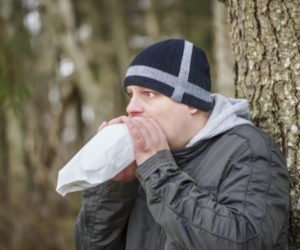Inhalant Addiction and Abuse

How to recognize inhalant addiction and abuse in teens
Inhalant abuse, which involves deliberately inhaling the vapors of substances to get high, is often overlooked when parents monitor their children for signs of drug abuse. Inhalant addiction and abuse occurs in teens from every segment of society, because there is no need for contact with drug dealers. The solvents and aerosols used in inhalant abuse are readily available in every home, school, and office, so teens can engage in inhalant abuse without having to leave the home to procure a prescription or buy illicit drugs. Deliberately inhaling the vapors from these products even once can cause serious, possibly permanent health consequences. For that reason, learning how to identify inhalant addiction and abuse should be a top priority for the parents of teens and preteens. To help parents protect their loved ones from this deadly scourge, we provide the answers to common questions about inhalants.
What are inhalants and how are they used?
The term “inhalants” covers a broad range of substances that produce pharmacological effects and are ingested by inhaling. These chemicals can be found in household, industrial, and medical products and can be used by huffing, bagging, sniffing, or snorting. They fall into four general categories:
- Volatile solvents – Liquids that exude vapors that can be inhaled. Volatile solvents are readily available in households and industrial settings. They include paint thinners, cleaning fluids, gasoline, felt-tip markers, correction fluids, and glues. Solvents offer a very short high that may only last for a few minutes, so users need to repeatedly inhale them every few minutes in order to create a sustained high.
- Aerosols – Inhalants in the form of sprays that contain propellants and solvents to disperse their contents are favorites of teenagers, because they are cheap and easy to obtain. Aerosol inhalants include spray paint cans, hair spray, deodorants, cooking oil sprays, and fabric protectors. Inhaling aerosols produces a disconnected, “zoned out” feeling followed by a mild crash.
- Gases – Inhalants in gaseous form include medical anesthetics such as choloroform, halothane, and nitrous oxide (laughing gas);propellants in everyday items including whipping cream; and can be found in lighter fluid, propane tanks, and some refrigerants. Users spray the propellants into a bag and inhale to obtain a high similar to ether or other anesthetics.
- Nitrates –Known as “poppers,” inhalants that contain amyl, butyl, and cyclohexyl nitrites and other related compounds are banned by the Consumer Product Safety Commission, but still sold in small bottles as Liquid Aroma or Room Deodorizers. Mainly used by adults to enhance sexual experiences.
Are inhalants addictive?
Inhalants, like other intoxicating substances, can be addictive when used repeatedly over a long period of time. Abruptly stopping inhalant use can cause withdrawal symptoms that include headaches, aches and pains, sleeplessness, mood swings, depression, and a strong craving for the drug.
How can you recognize signs of inhalant addiction and abuse?
With the exception of nitrates, inhalants are central nervous system depressants that create effects that are similar to alcohol use and may include slurred speech, decreased coordination, inattentiveness, and depression. If your teen exhibits these symptoms of inhalant use, look for physical signs that can indicate inhalant addiction such as chemical odors on breath and clothing, paint stains of face, hands, or clothes, and the presence of chemical-soaked clothing or rags.
What treatment is available for inhalant abuse?
If you see the signs of inhalant addiction and abuse in your teen, please call the White Sands Treatment Center at (877) 855-3470. The addiction specialists can assist you in finding the best treatments options to help your teen.
While there is no medication that can help with inhalant abuse, addiction counseling and treatment programs can help teens recover from inhalant addiction and abuse. Inhalant addiction treatment that consists of abstinence strategies, behavioral therapy, group therapy, education about the causes of drug abuse, and relapse prevention can help teens achieve a long lasting recovery from inhalant abuse.
If you or a loved one needs help with abuse and/or treatment, please call the WhiteSands Treatment at (877) 855-3470. Our addiction specialists can assess your recovery needs and help you get the addiction treatment that provides the best chance for your long-term recovery.
